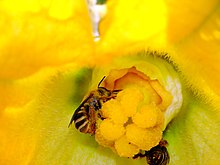Squash bee
| Squash bee | |
|---|---|
 |
|
| Peponapis pruinosa | |
| Scientific classification | |
| Kingdom: | Animalia |
| Phylum: | Arthropoda |
| Class: | Insecta |
| Order: | Hymenoptera |
| Family: | Apidae |
| Subfamily: | Apinae |
| Tribe: | Eucerini |
| Genera | |
The name squash bee, also squash and gourd bee, is applied to two related genera of bees in the tribe Eucerini; Peponapis and Xenoglossa. Both genera are oligoleges (pollen specialists) on the plant genus Cucurbita and closely related plants, such as cucumbers. They are small genera, containing only 13 and seven described species, respectively, and their combined range is nearly identical to the range of Cucurbita in the New World, from South America to North America. Their range has become somewhat expanded along with the movement of cucurbits into other areas (as crop plants). These bees are of moderate size, equal to various bumblebees. The pollen-carrying hairs on their legs (the scopa) are unbranched or nearly so, and sparse, to accommodate the exceptionally large, coarse pollen of the host plants. They have also evolved a matinal daily activity cycle, flying before sunrise. Some Xenoglossa species have become morphologically specialized to fly while it is still dark, with greatly enlarged ocelli to allow them to fly in near-darkness.
The two genera are sometimes thought to be sister taxa, but enough differences occur between them to suggest the similarities may be due to convergent evolution, based on their adaptation to use the same host plants.
Studies have been carried out to compare Peponapis and honey bees regarding their effectiveness in pollinating cucurbits. The findings point to the squash bees being more effective and suggest the current practice of renting colonies of honey bees to perform this task may be unnecessary.
Species such as Peponapis pruinosa have been in decline due to several reasons, probably at least in part to pesticide sensitivity.
...
Wikipedia
